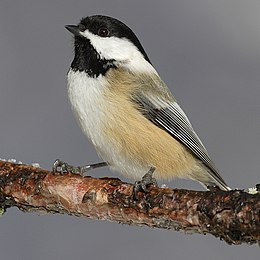Black-capped chickadee
| Black-capped chickadee | |
|---|---|
 |
|
| Scientific classification | |
| Kingdom: | Animalia |
| Phylum: | Chordata |
| Class: | Aves |
| Order: | Passeriformes |
| Family: | Paridae |
| Genus: | Poecile |
| Species: | P. atricapillus |
| Binomial name | |
|
Poecile atricapillus (Linnaeus, 1766) |
|
| Synonyms | |
|
Parus atricapillus |
|
Parus atricapillus
The black-capped chickadee (Poecile atricapillus) is a small, nonmigratory, North American songbird that lives in deciduous and mixed forests. It is a passerine bird in the tit family Paridae. It is the state bird of both Maine and Massachusetts in the United States, and the provincial bird of New Brunswick in Canada. It is well known for its capacity to lower its body temperature during cold winter nights as well as its good spatial memory to relocate the caches where it stores food, and its boldness near humans (sometimes feeding from the hand).
Though often placed in the genus Parus with most other tits, mtDNA sequence data and morphology suggest that separating Poecile more adequately expresses these birds' relationships. The American Ornithologists' Union has treated Poecile as a distinct genus for some time.
The genus name Poecile has often been treated as feminine (giving the species name ending atricapilla); however, this was not specified by the original genus author Johann Jakob Kaup, and under the ICZN, the genus name must therefore be treated by default as masculine, giving the name ending atricapillus.
At one time the black-capped chickadee was considered by some to be conspecific with the willow tit of Eurasia, due to their very similar appearance. This is reflected in an older version of the Peterson Field Guide for the Birds of Britain and Europe, which states "N Am. Black-Capped Chickadee" as an alternate name for the willow tit. In fact the willow tit, black-capped chickadee, marsh tit and Carolina chickadee are all very similar to one another in appearance.
The black-capped chickadee has a black cap and "bib" with white sides to the face. Its underparts are white with rusty brown on the flanks. Its back is gray and the tail is normally slate-gray. This bird has a short dark bill of 8–9.5 mm (0.31–0.37 in), short rounded wings 63.5–67.5 mm (2.50–2.66 in), a tarsus of 16–17 mm (0.63–0.67 in) and a long tail at 58–63 mm (2.3–2.5 in). Total body length is 12–15 cm (4.7–5.9 in), wingspan is 16–21 cm (6.3–8.3 in) and body mass is 9–14 g (0.32–0.49 oz). Sexes look alike, but males are slightly larger and longer than females.
...
Wikipedia

